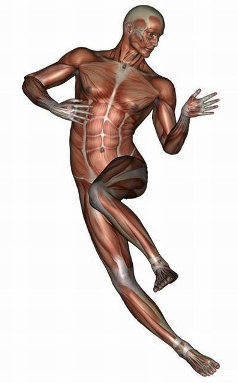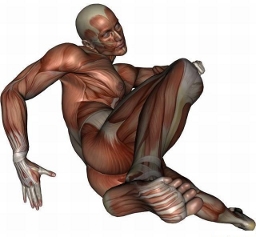Sports, Cycling, and Exercise
Introduction
The pelvic floor, as part of the body's core system of stability and movement, plays a significant role in all physical exertion and that role is heightened with the increased intensity and effort required of various athletic endeavors. Movement is initiated here, and the pelvic floor functions closely together with other essential components of the core including the Transversus Abdominis in the abdomen and the Multifidus muscles in the low back and sacrum. The contribution of these muscles enables the wide range of movement and effort required in sports while safe-guarding the integrity of the pelvic, sacral, and spinal joints. Physical activity also requires increased base-line tone in the pelvic floor muscles as well as short bursts of intense contraction. This ensures support for the organs above it and maintains urinary and anal closure to prevent leakage. A strong pelvic floor can give you a wonderful sense of power in your core.
My pelvic floor work will help you identify these important muscles and learn how they relate to your physical activities. I also offer exercise guidance for those wishing to strengthen this component of their core, including how to contract them in isolation and a printed exercise protocol. Many men choose to include pelvic floor work as part of a core massage and bodywork session which focuses on the low back, pelvis, hips, thighs, and lower abdomen.
Cycling has a much higher potential to adversely affect the pelvic floor (including the genitals) due to direct and significant compression of these tissues by the bicycle seat. See the Cycling section below for a full discussion of these effects and the role of massage and bodywork in restoring normal sensation and function.
Hover your cursor over citation numbers to view the source in a pop-up text box or scroll to the bottom of the page for the full list. "Back to top" links are found to the right at the end of each section below.
Sports
Though any athletic endeavor can result in pelvic floor injury, dysfunction, discomfort, or pain, certain sports have a higher risk. Foremost among them is cycling, which will be discussed in the next section. According to Wise and Anderson, weight lifting is considered a risk factor for Chronic Pelvic Pain Syndrome [1]. Weight lifting requires strong and responsive core muscles to brace against the effort required to lift.
 Weakness, a momentary lapse, or mis-timed contractions can all put the pelvic floor at risk. Liberi and Liberi, in a 2011 article in the International Journal of Athletic Therapy and Training, add that "With increasing participation in rodeo, equestrian sports, and extreme sports (e.g. skateboarding, snowboarding, and BMX cycling), injuries to the pelvic floor and perineum are likely to become more prevalent." [2]. In their view, "Lower urinary tract symptoms (LUTS), prostatitis, and pudendal neuralgia [pain along the distribution of the pudendal nerve] are the most common causes of pelvic pain and pelvic floor dysfuntion in male athletes."
Weakness, a momentary lapse, or mis-timed contractions can all put the pelvic floor at risk. Liberi and Liberi, in a 2011 article in the International Journal of Athletic Therapy and Training, add that "With increasing participation in rodeo, equestrian sports, and extreme sports (e.g. skateboarding, snowboarding, and BMX cycling), injuries to the pelvic floor and perineum are likely to become more prevalent." [2]. In their view, "Lower urinary tract symptoms (LUTS), prostatitis, and pudendal neuralgia [pain along the distribution of the pudendal nerve] are the most common causes of pelvic pain and pelvic floor dysfuntion in male athletes."
"Your pelvic floor work was very liberating in terms of my workouts." - C. B.
Excess tension or weakness, as well as spasm and trigger point referral can cause pain and dysfunction in the pelvic floor and perineum, the genitals, the coccyx (tail bone), rectum, groin, thighs, lower abdomen and low back. Through massage and bodywork I will help you identify these important muscles and work with you to relax and lengthen them to restore normal tone and function. For those who wish to strengthen these muscles as part of their core training I will help you learn to properly contract them and provide an exercise protocol. If you have no particular pelvic floor issues and are simply curious, massage and bodywork can be a wonderful way to gain greater awareness of this important part of the core musculature and explore its relationship to the rest of your body.Back to top
Cycling
More research has been published regarding cycling and pelvic floor / perineum dysfunction and pain than for all other sports. Though bicycling is an excellent non-impact aerobic exercise with many health benefits, some cyclists will experience urogenital disorders associated with pelvic floor compression, most often perineal pain, genital numbness, and erectile dysfunction (ED). "There is a significant relationship between cycling-induced perineal compression leading to vascular [blood], endothelial [cells lining internal structures], and neurogenic [caused by nerves] dysfunction in men and the development of ED." report Sommer and colleagues in a 2010 Journal of Sexual Medicine review [3]. Hakim writes that "Bicycle riding and the blunt trauma, which may be associated with the constant perineal pressure from a narrow, unpadded bicycle seat or crossbar, has been implicated as the underlying cause of lower urinary tract symptoms (LUTS) / voiding dysfunction and ED in many men in this population." [4]. Leibovitch and Mor, in 2005, report that "With increasing levels of bicycle riding exposure, males are found to have significantly more urological complaints, perineal pain, or numbness." [5]. They add that "since perineal symptoms, genital numbness, and especially ED may be still regarded as sensitive issues, the reported incidences of such symptoms may underestimate the phenomenon."

Benjamin observes that "most bike seats make us sit on our perineums, resting on the ischiopubic rami [the segments connecting the pubic and ischial bones of the pelvis] and the internal part of the genitals. This area of the body was not designed to be weight-bearing." [6]. Sitting on a slim, often hard saddle while cycling generates extreme perineal pressure. In a 2001 study Sommer et al. found that "A 70% average reduction in blood flow through the penile artery was measured when subjects cycled on the average bike saddle." [7]. They state that 61% of the cyclists interviewed reported numbness in the genital region, and 24% complained of erectile dysfunction. Leibovitch and Mor [5] maintain that "the association of ED with bicycling was investigated in multiple studies, which repeatedly demonstrated increased risk of ED in cyclists."
"You really are very good - a great quality of touch. It is so nice to fully trust letting my body be in your hands - you have healing hands and energy." - C. W.
For a comparative understanding of the pressure a bicycle seat exerts on the pelvic floor, this excerpt from a paper published by the National Institute for Occupational Safety and Health (NIOSH) in 2009 is worth keeping in mind. The authors state that "Other NIOSH studies showed that pressure on a traditional (nosed) bicycle saddle in the area under the bicyclist's groin is typically 2.90 pounds per square inch during cycling and may reach as high as 5.37 pounds per square inch. As a point of reference, the pressure on an arm blood pressure cuff needed to restrict blood flow in the arteries is about 120 mm Hg, which is equal to 2.32 pounds per square inch." [8].This tells us that the pressure on the pelvic floor and perineum when riding on a traditional saddle is higher than that required to cut off circulation in the arm with blood pressure cuffs. No wonder that problems in the perineum, pelvic floor, and genitals can result.
Though not widespread, there are choices beyond the standard bicycle seat. Most feature a design that incorporates a no-nose configuration or a design that allows the weight of body to be transferred to the saddle via the sits bones (ischial tuberosities) rather than the perineum and front of the pelvic floor. Padding and seat angle adjustments are also important considerations.
Cycling-related pelvic floor tension, compression, circulation, or sensation issues that result in numbness, discomfort, pain, or urogenital dysfunction can benefit from skilled pelvic floor massage and bodywork to help restore normal blood flow, tone, feeling, and function.Back to top
Exercise
"I felt lighter during my workouts after our first session." - J. K.
All sports whose movements involve the trunk and legs will require concurrent contractions of the pelvic floor muscles, usually automatically. There are, however, various exercise approaches in which specific attention can be given to these muscles. Yoga, martial arts, and pilates are some examples.
My massage and bodywork sessions are a great way to become aware of these important muscles and to learn how to isolate them for proper contractions - a necessary first step in any exercise regimen. I also offer guidance in setting up an exercise protocol and printed instructions for home use. Stand-alone pelvic floor muscle exercises are described by several authors in their publications cited on this website, including Dorey [9], Stein [10], Franklin [11], Sommer [12], Morin [13], and Liebenson [14].
See my Maintaining a Healthy Pelvic Floor page for more on exercise, physical activity, stretching, and yoga. See my Emotional and Energetic Aspects page for pelvic floor meridians and points related to martial arts and Traditional Chinese Medicine (TCM).
References
Books are in bold regular text and journal articles are in bold italic text
[1] Wise D and Anderson R. A Headache in the Pelvis: A New Understanding and Treatment for Chronic Pelvic Pain Syndromes, 6th ed. National Center for Pelvic Pain Research, 2010.
[2] Liberi V and Liberi KH. Pelvic Pain and Pelvic Floor Dysfunction in Male Athletes. International Journal of Athletic Therapy and Training 2011; 16(1): 8-12.
[3] Sommer F, Goldstein I, Korda J. Bicycle Riding and Erectile Dysfunction: A Review. Journal of Sexual Medicine 2010; 7(7): 2346-2358.
[4] Hakim LS, writing in Chronic Prostatitis / Chronic Pelvic Pain Syndrome. Shoskes DA, ed. Humana Press, 2008.
[5] Leibovitch I and Mor Yoram. The Vicious Cycling: Bicycling Related Urogenital Disorders. European Urology 2005; 47: 277-287.
[6] Benjamin B. Cycling and Your Health. Massage Therapy Journal. Summer 2004.
[7] Sommer F et al. Impotence and Genital Numbness in Cyclists. International Journal of Sports Medicine 2001; 22: 410-413.
[8] No-nose Saddles for Preventing Genital Numbness and Sexual Dysfunction from Occupational Bicycling. A "Workplace Solutions" paper from the National Institute for Occupational Safety and Health, 2009. Available at: cdc.gov/niosh/docs/wp-solutions/2009-131/pdfs/2009-131.pdf
[9] Dorey G. Pelvic Floor Exercises for Erectile Dysfunction. Whurr Publishers, 2004.
[10] Stein A. Heal Pelvic Pain. McGraw-Hill, 2009.
[11] Franklin E. Pelvic Power. Elysian Editions, Princeton Book Co., 2002 / 2003.
[12] Sommer F. VigorRobic: Increased Potency Through Specific Fitness Training. Meyer and Meyer Sport, 2002.
[13] Morin J. Anal Pleasure and Health. Down There Press, 2010.
[14] Liebenson C. Rehabilitation of the Spine, 2nd ed. Lippincott Williams & Wilkins, 2007.
